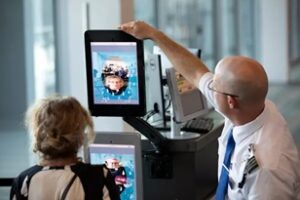
Following on from our previous piece on the facial recognition market, the integration of biometric security solutions is also playing a pivotal role in augmenting the effectiveness of security screening processes. Biometrics authentication methods, such as fingerprint, iris, and facial recognition technologies, offer high security by accurately verifying the identities of individuals entering or exiting the country.
The security screening market is valued at USD 9.4 billion in 2024 and is expected to reach USD 13.2 billion by 2029, growing at a CAGR of 7.1% from 2024 to 2029. The key factors, found by researchers at Marketsandmarkets, thought to be contributing to the growth of the security screening market include, increasing emphasis on modern security solutions to curb radiological attacks, and rising popularity of biometric security systems.
Many organisations use biometric technology to control physical and logical access and reduce the risk of data theft. They found that the IT industry is a key player in the growth of the biometrics market. Biometrics are commonly used in IT companies to control access, record employee attendance, and prevent theft or leakage of important information.
People screening is still one of the main uses of security screening systems at different places, such as airports, shopping malls, hotels and resorts, and corporate offices. Once reserved for access to secure areas, people screening has now become commonplace.
People screening systems are deployed at airports, government offices, correction facilities, stadiums, movie theatres, and cruise ships. X-ray systems, metal detectors, body scanners, biometric systems, and spectrometry & spectroscopy solutions are commonly used for people screening.
Continuous advancements in screening technologies, such as millimeter-wave scanners, full-body scanners, biometric identification systems, and artificial intelligence algorithms, have enhanced the accuracy and efficiency of screening processes. With the growth in international travel and the development of transportation infrastructure, there is a high need for efficient and effective passenger screening processes to ensure the safety and security of passengers at airports, ports, railway stations, and other transit hubs.
The scope of the transportation sector encompasses crucial transit locations such as airports, seaports, rail stations, and bus stations, where a significant increase in global passenger traffic is anticipated by 2025. To ensure security at these sites, contraband detection systems such as metal detectors and X-ray scanners are extensively utilised. The transportation sector is expected to lead the security screening market during the forecast period. Security screening products such as metal detectors, X-ray screening systems, and biometric systems are installed on a large scale at airports, railway stations, and several other transit points. They help authorities scan passengers and their belongings and prevent illegal activities.
North America holds the leading position in the security screening market. There is a massive opportunity for the security screening market in the aviation industry. The US, Canada, and Mexico are among the top 5 countries with the most airports. These three countries together have 16,694 airports. This increases the need to secure people and their belongings at airports. The need for personal security in developed countries and regions will always be high due to the high crime rate, smuggling, and threats of terrorism.
The security screening market in North America is witnessing significant developments amidst rising concerns over illicit fentanyl smuggling and other security threats. Illegal fentanyl smuggling poses a significant challenge at the US–Mexico border, with seizures of the potent drug increasing by 480% at the southern border from fiscal year 2020 to 2023.
As seizures of illicit substances, including potent drugs like fentanyl, continue to rise, there is an increasing demand for advanced technologies capable of effectively identifying and intercepting such contraband at ports of entry.
Furthermore, the integration of biometric security solutions plays a pivotal role in augmenting the effectiveness of security screening processes. Biometrics authentication methods, such as fingerprint, iris, and facial recognition technologies, offer high security by accurately verifying the identities of individuals entering or exiting the country.
In 2023, global passenger traffic is projected to reach 94% of the 2019 level, with North America estimated to be near its 2019 level by the end of the year, reaching 2.0 billion passengers or 99.8% of the 2019 level. As airports navigate the path to recovery, bolstering security measures remains a priority, especially considering the rising concerns over illicit fentanyl smuggling and other security threats. This underscores the importance of implementing advanced security screening technologies and biometric security solutions to effectively identify and intercept contraband while enhancing identity verification processes at ports of entry.











